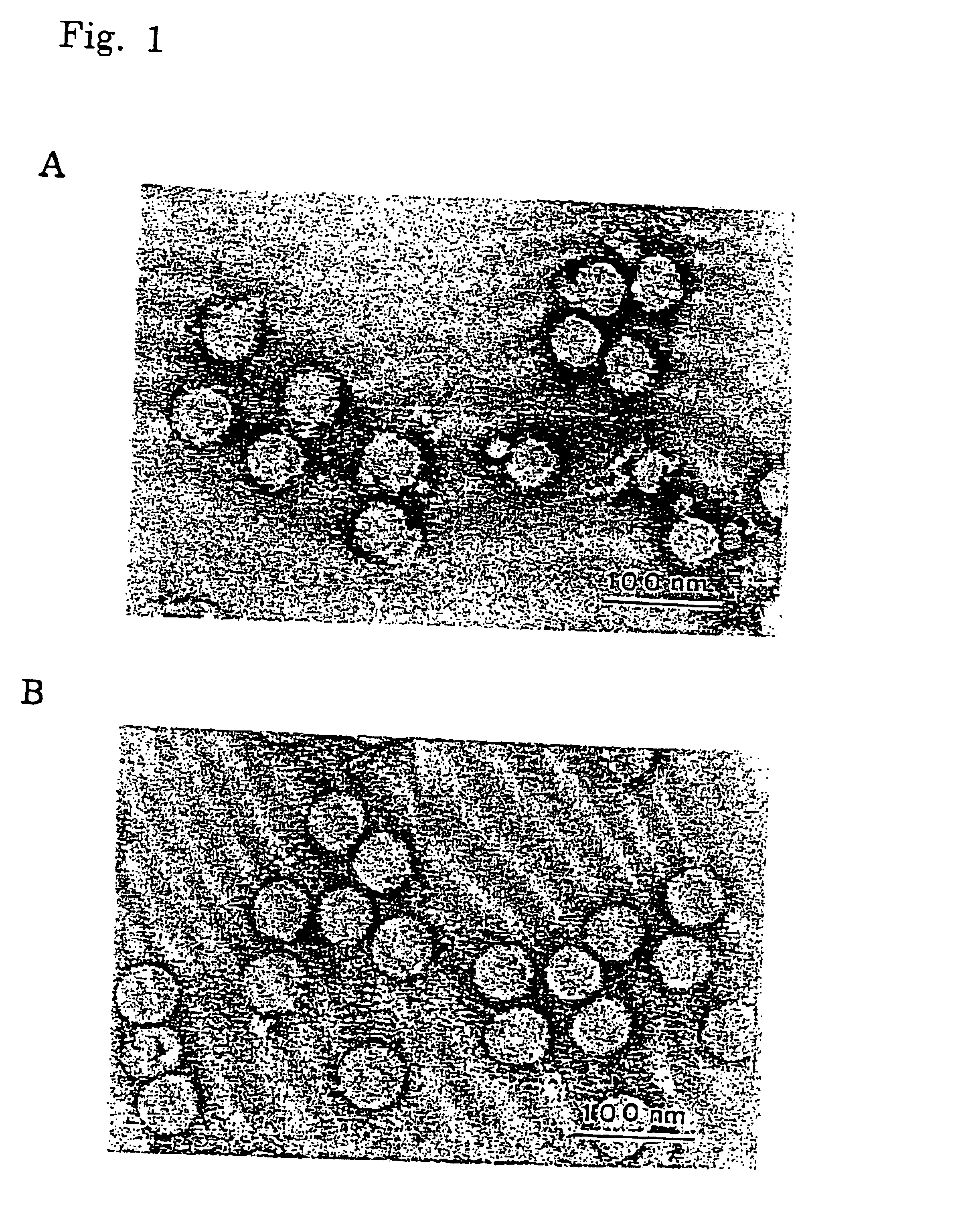Enhanced immunogen for inactivated vaccine for infection with Japanese encephalitis viruses and process for producing the same
a technology of inactivated vaccine and enhanced immunogen, which is applied in the field of enhanced immunogen for inactivated vaccine for infection with japanese encephalitis viruses and the process for producing the same, can solve the problems of low purity of such a vaccine, induce allergic neurological disorders, and practically impossible to obtain the large amount of primary cell cultures required for large-scale production of inactivated vaccine antigens
- Summary
- Abstract
- Description
- Claims
- Application Information
AI Technical Summary
Benefits of technology
Problems solved by technology
Method used
Image
Examples
experiment 1
Measurement of a virus infection titer: A virus infection titer was counted in PFUs (plaque-forming unit) / ml by a plaque-counting method using Vero-M cells described later.
Measurement of a virus antigen amount: An amount of Japanese encephalitis virus antigen was measured by ELISA using an anti-Japanese encephalitis virus monoclonal antibody IgG (Group-8 Clone 503 (kindly provided by Dr. Yasui, Tokyo Metropolitan Institute for Neurosciences; K. Yasui et al., Journal of General Virology, 67, 2663-2672, 1986). An ELISA value was calculated by a parallel line assay as a relative value when the value of an in-house standard product (Beijing strain) derived from mouse brain is defined as 100 units.
HA test: A U-shaped microplate was used. Equal amounts of 0.33% (v / v) goose red blood cell suspension adjusted to optimum pH with a phosphate buffer and virus solution were mixed. Thereafter, they were allowed to be reacted with each other at 37.degree. C. for 60 minutes. Thus, the presence of ...
experiment 2
Proliferation in a cell line for virus culture: Adhesive 2-strain Vero cells: Vero-A (ATCC No. CCL-81) and Vero-M (Vero obtained from the National Institute of Infectious Diseases); 3-strain BHK-21 cells: BHK / WI2 (adhesive BHK-21 obtained from the Osaka prefectural Institute of Public Health), BHK / JHIH (suspended BHK-21 obtained from the National Institute of Animal Health) and BHK-21 [C-13] (ATCC No. CCL-10); and a C6 / 36 cell (ATCC No. CRL-1660) derived from a mosquito were used as candidate cell lines for virus culture, and viral propagation in each cell line was observed. Vero-A, Vero-M, BHK / WI2, and BHK-21 [C-13] were each prepared in a growth medium at about 1.5.times.10.sup.5 cells / ml. They were statically incubated at about 37.degree. C. for 3 days, and thereafter, the number of cells were respectively counted. In the same way as this, suspended BHK / JNIH was prepared at about 2.0.times.10.sup.5 cells / ml, and was incubated with shaking at about 37.degree. C. for 3 days. Therea...
experiment 3
Propagation of Japanese encephalitis virus in candidate cell lines: C6 / 36 was incubated at about 28.degree. C. for 7 days, and the other cells used in Experiment 2 were incubated at about 37.degree. C. for 3 days. Thereafter, each cell was inoculated with a Beijing strain at a multiplicity of infection (MOI) of 0.1, and measured for a virus infection titer (PFU), a virus antigen amount (ELISA titer), and an HA titer, whereby the time course of the change in extracellular virus amount was compared. Table 1 shows the results. Each numerical value is an average of the highest values in virus growth curves of each cell line for duplicate experiments. C6 / 36 exhibited the highest virus infection titer on the 3rd day from the commencement of incubation, and exhibited the highest ELISA titer and HA titer on the 4th day. The other cell lines exhibited the highest virus infection titer on the 2nd day from the commencement of incubation, and exhibited the highest ELISA titer and HA titer on th...
PUM
| Property | Measurement | Unit |
|---|---|---|
| Angle | aaaaa | aaaaa |
| Volume | aaaaa | aaaaa |
| Volume | aaaaa | aaaaa |
Abstract
Description
Claims
Application Information
 Login to View More
Login to View More - R&D
- Intellectual Property
- Life Sciences
- Materials
- Tech Scout
- Unparalleled Data Quality
- Higher Quality Content
- 60% Fewer Hallucinations
Browse by: Latest US Patents, China's latest patents, Technical Efficacy Thesaurus, Application Domain, Technology Topic, Popular Technical Reports.
© 2025 PatSnap. All rights reserved.Legal|Privacy policy|Modern Slavery Act Transparency Statement|Sitemap|About US| Contact US: help@patsnap.com

